Application of nanomaterials and nanotechnologies in construction. Рубрика в журнале - Nanotechnologies in Construction: A Scientific Internet-Journal
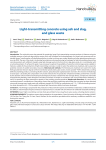
Light-transmitting concrete using ash and slag, and glass waste
Статья научная
Introduction. The article discusses the potential for producing “green” light-transmitting concrete products in Vietnam using the available resources of ash and slag and glass waste, which will contribute to the development of a closed-cycle economy and sustainable “green” transformation of industrial production in order to achieve zero carbon dioxide and other greenhouse gases emissions by 2050. The aim of the study is to develop formulations and manufacturing technologies for light-transmitting cement-free concrete products with sufficient strength using high-tonnage waste in the form of ash, slag, glass waste, etc. in combination with an activating solution. To achieve this goal, it was necessary to explore the possibility of using the multi-tonnage waste available in Vietnam, suitable for the production of light-transmitting concretes, in order to select the optimal raw materials, and to assess the potential volumes of suitable secondary resources. Materials and methods. The following raw materials were used in the study: finely ground blast furnace slag, fly ash from incineration power plants, glass waste, ceramic powder “TOTO”, obtained by crushing defective plumbing products, activating alkaline solution, polycarboxylate superplasticizer and water. The research methodology is based upon calculating the compositions of concrete mixtures for the production of light-transmitting cement-free concretes by the absolute volume method and testing the developed concretes to determine their average density, compressive and tensile strength during bending, water absorption and natural moisture of samples in accordance with current Vietnamese standards, as well as in assessing the light transmission capacity of the resulting concrete products. Results and discussion. As a result of the conducted research, compositions of decorative cement-free and light-conducting optical fiber-free concretes has been obtained using multi-tonnage man-made waste with sufficient strength (40÷50 MPa for compression and 11.5÷13 MPa for bending tension), low water absorption (6.5÷10% by weight) and good light transmission ability have been developed. Conclusion. A technology is proposed for the production of decorative thin panels and wall tiles in laboratory conditions that have the ability to transmit light and give architectural expressiveness to outside walls and interiors of residential and public buildings.
Бесплатно
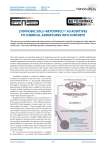
Lyophobic sols «БЕТОПРЕСС»® as additives to chemical admixtures into concrete
Статья научная
The article presents an innovative approach to enhancing cement concrete, bordering on a scientific breakthrough, and explains it in a way that is easy to understand. The core concept is the integration of a reactive agent with a chemical fluid to augment the material and endow it with novel characteristics. The technique, as suggested by the author, involves utilizing lyophobic sols that they have formulated as admixtures, combined with aqueous solutions of chemical additives produced by Russian companies. Due to the inclusion of these Nanostructured sols in the chemical additives, heavy cement concrete treated in this manner shows remarkable resilience. It remains unaffected by repeated freeze-thaw cycles, even when immersed in saline or mineral-rich waters. Furthermore, this advanced concrete does not demand any special measures for protection, maintenance, or repair, nor does it require additional waterproofing.
Бесплатно
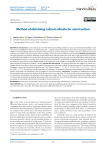
Method of obtaining calcium silicate for construction
Статья научная
Introduction. Calcium silicate is one of the well-known building materials. Its structure determines the ability of such nanostructured additives to form a secondary structure – a fractal (volumetrical) network with which cement grains interact. The addition of nanomodifying additives to improve the technology of cement production will reduce the space dimension in which molecules are sorbed on the cement grain, and, accordingly, increase the rate and efficiency of its blocking. Methods and materials. The paper proposes a method for obtaining calcium silicate from soda ash production waste. The sol-gel method for the synthesis of individual nanomodifiers in the silicate form will improve the technology for producing concretes by forming a solid phase state of the modified structure of a cement stone. In the production of soda ash, the land plots (sludge accumulators) are allocated for the collection of production waste (distiller liquid). In this regard, the acute problem is a disposition of industry waste, because the area allocated for sludge accumulators is limited. Results and discussions. The study revealed that the addition of certain components allows us not only to reduce the required firing temperature, but also to affect the nanostructure of the resulting product. The range of values of the content of additives per 5 g of calcium silicate: С – 0.2÷0.4; S – 0.3÷0.5; ZnO – 0.1÷0.3; P2O5 – 0.3÷0.5; NH2CONH2 – 0.3÷0.3. According to the obtained matrix of conditions, 16 samples of substances were prepared. Nanomodification of cement stone leads to its hardening in the early stages of structure formation. Conclusion. The addition of hydroperite to calcium silicate significantly increases the hardness of the final product; when coal, sulfur, zinc oxide and phosphorus pentoxide are added as components, the hardness and structure of the compound changes. Thus, the use of a nanostructured cement additive based on calcium silicate obtained by qualified processing of the main waste that is part of the distiller liquid - calcium oxide, will improve the quality of concrete by improving the technology of cement production
Бесплатно
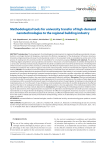
Статья научная
Introduction. The development of methodological monitoring tools to implement building nanomaterials into production is an integral element of designing a mechanism for effective management of the development of business structures. University entrepreneurship and research and educational centers in the ecosystem trend are considered as central actors in the process of creating tools for university transfer of nanobinders for construction purposes. Methods and materials. The process of forming digital competencies among students and teachers in the process of commercialization of scientific developments of a construction university (institute, faculty, department) should be considered as the result of fractal interactions. The development of the innovative ecosystem of the university is achieved by the effective implementation of the process of transferring the results of intellectual activity for the creation of gypsum and ceramic nanocomposites, which are in demand by the regional construction industry. Results. The intellectual and technological potential of universities that train bachelor’s and master’s students for the construction industry determines the prospects for the successful development of the industry in an innovative society. Accelerated promotion of investment developments, requested nanotechnologies of universities, provides universities with additional extrabudgetary funding. On the example of the development of technology for producing small-piece wall and partition products based on nanostructured gypsum binders, they were tested in experimental industrial conditions. Discussion. Effective methodological tools for the transfer of nanotechnological university engineering to the construction industry are: the creation of basic departments at enterprises and the successful functioning of research and educational centers, the participation of employers in educational and industrial practice, etc. From the point of view of laborious commercialization and transfer of scientific developments, the effective way from the idea to the widespread introduction of high-tech products is the real application of the intellectual potential of the teaching staff of the university, institute, departments. Conclusions. The engineering of methodological tools for reliable monitoring of the attractiveness of the regional business ecosystem for the generation and development of transfer processes of popular nanomaterials is an integral element of designing a mechanism for effective management of business structures in construction. Due to the formation of the innovative ecosystem of the university, an effective implementation of the process of commercialization of the results of intellectual activity in the field of nanotechnology, which are in demand by the construction industry of the region, is achieved.
Бесплатно
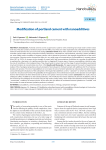
Modification of portland cement with nanoadditives
Статья научная
Introduction. Portland cement slurries (suspensions) used for well cementing have high water-cement ratios (0.45–0.6). They also contain a minimum amount of inert fillers, must have zero water separation and controlled hardening with a minimum time between the start and end of setting. Literature review. Most of the scientific work on the use of nano-additives in binder systems relates to the construction industry. Nanosilicon, nanotitanium, nanocarbonate, nanoclays, carbon nanofibers, etc. were widely used as modifiers of cement systems, which showed an increase in the strength characteristics of the resulting concretes. Literature review showed that there is a very wide range of concentrations of nanoadditives in cement systems from 0.001 to 10.0%. An increase in the strength of cement with high concentrations of additives in a number of publications is explained by a decrease in its capillary porosity due to clogging of the pore space. However, nanoadditives should not play the role of microfillers in the hardened stone. They should work in cement slurry at the stage of cement hydration and cement structure formation at concentrations less than 1.0%. Results and Discussion. The paper presents the results of experimental studies of the rheological properties and early strength of stone based on Portland cement with additives (0.01%) of nanocarbonate and nanoiron. The role of nanoadditives is to increase the rate of cement hydration by reducing the activation energy, and accelerating the dissolution of the solid phase in the liquid. Nanoadditives can be a “substrate” on which two-dimensional nuclei of a new phase are formed. The probability of the appearance of two-dimensional nuclei on the substrate is much higher than for the formation of three-dimensional nuclei of a new phase in the bulk of the solution. Conclusion. The results show an ambiguous effect of additives on the tested parameters, which indicates the need to optimize the amount of additives. One of the reasons for the ambiguity of the results may be high water-cement ratios, which reduce the likelihood of the formation of “constrained” conditions in cement slurries. At the same time, the effects of accelerated cement hydration are “levelled” and the number of contacts between hydration products is reduced.
Бесплатно
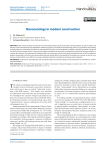
Nanocoatings in modern construction
Статья научная
The review analyzes the state of the nanocoating market, shows main types of nanocoatings, as well as drivers and barriers to their development and application. Modern progress in the field of nanotechnology allows us to attribute nanocoating to high performance materials, the structure and properties of which can be “designed” according to specific functional criteria and the level of environmental impact. They present unique remarkable characteristics compared to conventional coating materials in construction industry. The government’s grandiose plans to commission new housing and road infrastructure, as well as ambitious projects to develop the Arctic and ensure national security, should lead to the growth of the industry as a whole, as well as to an increase in demand for more efficient, innovative building materials, including nanocoatings and nanopaints.
Бесплатно
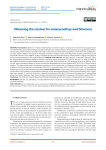
Obtaining the retainer for waterproofing road bitumens
Статья научная
Bitumen is a mixture of hydrocarbons and hetero-organic compounds. It is one of the most popular building materials today. Due to the growing consumption of bitumen for various purposes, the requirements for its quality characteristics are increasing, which prompts a comprehensive study of the physical and mechanical properties and methods of its modification. Currently, various additives are used, from inorganic materials to organic binders, including waste chemical, petrochemical and household industries. These additives create a nanodispersed structure inside the bitumen, which provides a change in the physical and mechanical properties in the required direction. Methods and materials. The work proposes a method for obtaining a fixer for waterproofing road bitumen based on nitrogen-containing organic compounds. The goal of research is to study the effect of the additive-derivative of triethylenediaminedicyan, which leads to the formation of a nanodispersed structure of bitumen of the “sol-gel” type, the quality indicators of which will meet the requirements of the new standard GOST 33133-2014 “Viscous road oil bitumen”. The object of the study is the bitumen production unit of workshop No. 14 of Gazprom neftekhimSalavat LLC, designed to produce commercial bitumen: oil road grades CB 90/130 in accordance with GOST 22245-90, used in road, civil and industrial construction as a binder and waterproofing material. Results and discussion. In the course of the study, the nature of the interaction and the effect of the modifier on the properties of bitumen, which ensure the production of nanostructured bitumen of the “sol-gel” type, were revealed. As a result of the study, a comparative assessment of the effect of the fixer on the properties of waterproofing bitumen revealed a significant improvement in physical and mechanical properties in comparison with bitumen grade CB 90/130. Conclusion. The obtained compound based on triethylenediaminedicyancan can be used as a fixing additive to road bitumen
Бесплатно
Peculiarities of the formation of silicon oxide films modified with metal nanoparticles
Статья научная
Introduction. Silicon oxide film coatings have unique properties and are widely used in various industries, including construction. This paper presents the results on the preparation of polyalkylhydroxysiloxane liquid film in the presence of nanoscale particles of metallic bismuth. Methods and materials. Laser ablation method of metallic bismuth in aqueous medium was used to obtain bismuth nanoparticles. The surface of the target was treated with a laser beam at the workstation of an ytterbium pulsed fiber laser are discussed. The particle size and electrokinetic properties of colloidal bismuth sols were determined method by dynamic light scattering. After drying, Bi powder was added to polyalkylhydroxysiloxane liquid. Thin films cured under different heat treatment modes are applied to glass substrates by dipping. The resulting films were characterized by SEM, X-ray phase analysis, and FTIR spectroscopy. Results. In this work, the electrokinetic properties of colloidal bismuth sols are discussed. Laser ablation of a bismuth substrate leads to an increase in electrical conductivity and the appearance of a double electric layer in colloidal sols. The effect of the curing temperature on the properties of the coating is shown. It was found that the content of bismuth nanoparticles in the polyalkylhydroxysiloxane coating (3 wt.%) does not lead to the formation of crystalline phases. At the same time, the composition of the film and the mode of heat treatment affect the short-range order of molecular bonds. Increasing the content of bismuth nanoparticles in the coating of more than 10 wt.% leads to the appearance of microcrystalline phases of bismuth silicates in the system. Conclusion. The results obtained in the course of the study supplement the information about the production of bismuth nanoparticles by laser ablation and are of great importance in the practice of creating composite films.
Бесплатно
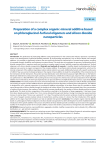
Статья научная
Introduction. The production of plasticizing additives using nanoparticles for the construction industry represents a promising sector in the development of advanced building materials. By incorporating nanoparticles, such as silicon dioxide, into complex additives, it is possible to significantly enhance the structural and mechanical characteristics of cement-based systems, resulting in increased strength, durability, and resistance to external forces. This study aims to investigate the process of synthesizing silicon dioxide nanoparticles in aqueous media and creating a complex organic-mineral additive comprising phloroglucinol- furfural oligomers with silicon dioxide nanoparticles. Materials and methods of research. A modifier based on phloroglucinol-furfural oligomers was used as an organic component of the complex additive. To synthesize silicon dioxide nanoparticles, which are the mineral component of the additive, liquid glass (sodium silicate solution) was used. Additionally, Aerosil, with a specific surface area of 2,000 m3/kg, was used as the dispersed phase in the organic mineral additive to study the compatibility of the components and the mechanism of their interaction. The particle and size distribution were determined using laser light diffraction on the Malvern Mastersizer 3000 device and dynamic light scattering on the Microtrac S3500 device. Microscopic analysis of the complex additive was performed on a TESCAN MIRA 3 LMU scanning electron microscope. The chemical structure and composition of the obtained additive were monitored by UV and IR spectrophotometry on Specord 200 Plus and Alpha Bruker Optics devices, respectively. Results and discussion. The article presents the results of the development of a method for the synthesis of silicon dioxide nanoparticles and creating an organic-mineral additive based on phloroglucinol-furfural oligomers containing these nanoparticles. The additive is designed for use in mineral suspensions in construction additive technologies. It has been shown that it is possible to obtain nanoscale particles of silicon dioxide through the hydrolysis of sodium silicate. It has been demonstrated that as the concentration of sodium silicate increases, the number of silica particles increases significantly, the number of silicon dioxide particles increases significantly. This leads to faster coagulation of the particles, resulting in the formation of larger aggregates. It has been shown that silicon dioxide particles smaller than 10 nm can be obtained through acid titration. During the maturation period, particles increase in size by about 7 times over a period of 1 to 7 days. The optimal ratio for particle synthesis should be considered to be a 2:1 ratio of reagent solutions (sodium silicate to hydrochloric acid) by volume. It is shown that the introduction of the specific additive at the stage of particle formation can help to stabilize their growth. Conclusion. The complex organic-mineral additive based on a phloroglucinol-furfural oligomer and silicon dioxide nanoparticles has been developed. It has been established that the introduction of the specific additive in the process of synthesis of silicon dioxide particles contributes to an increase in the aggregate stability of the dispersed system of the complex additive, reduces the tendency of particles to enlargement and sedimentation.
Бесплатно
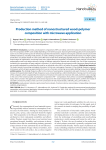
Production method of nanostructured wood-polymer composition with microwave application
Статья научная
Introduction. Currently, wood-polymer compositions (WPC) are widely used in the national economy and construction. The composition of WPC varies widely depending on the further purpose. Improving the binding quality in the wood-polymer system is one of the promising areas for enhancing operational characteristics. Organic and inorganic substrates nanostructured with individual substances, including metal particles, are used as binding components. In the petrochemical industry, most high-capacity productions use catalysts based on active carriers like heavy metals when developing targeted products for various purposes. After several stages of regeneration, recovering these heavy metals becomes impossible. Consequently, spent catalysts accumulate in sedimentation tanks and sludge collectors, lacking an efficient method for disposal and secondary use. One of the components included in the composition of spent catalysts is chromium (+6), which belongs to carcinogenic metals. Numerous disposal methods are currently inadequate for neutralizing this metal on an industrial scale, which is of interest for research. Methods and materials. The study is aimed at converting carcinogenic chromium (+6) into non-carcinogenic chromium (+3) by ultrahigh frequency exposure (microwave), which will open up opportunities for its use as a chromium-containing nanocomplex binding a tree-polymer. Results and discussions. The ultrahigh-frequency effect on the mixture of wood-polymer composition and spent chromium (+6) causes an increase in the penetration depth of high–frequency waves, characterized by a uniform distribution of energy over the entire area of the composite, which is explained by the reduction of chromium (VI) oxide into chromium (III) oxide, and there is also a change in the color of the nanostructured wood-polymer composition (WP – compositions) from yellow to malachite. Conclusion. This study, which consists in the application of microwave exposure to the wood-nanoparticle-polymer system, confirms the receipt of a durable construction product and its use in the construction of roofs, facade boards, sidewalks, piers, port facilities, etc.
Бесплатно
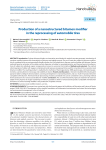
Production of a nanostructured bitumen modifier in the reprocessing of automobile tires
Статья научная
Introduction. Polymer-bitumen binders are innovative nano-binders for asphalt concrete pavement. Introduction of a polymer modifier improves the characteristics of bitumen and asphalt concrete. The use of waste tires rubber for bitumen modification is considered to be an environmentally friendly solution, but it is limited due to the poor cosite of rubber with bitumen. Various methods based on activation of the rubber surface, dispersion of rubber to nanosized particles, and thermochemical transformations of rubber into individual organic compounds are known to overcome this limitation. Methods and materials. The method of joint pyrolysis of rubber with oxygen-containing oil under pressure is proposed to be used for converting it into a nanostructural bitumen modifier. The resulting product is studied by the methods of thermogravimetry, NMR-spectroscopy, chromatomasspectrometry, scanning electron microscopy and solubility in toluene. Results and discussion. It has been established that during joint pyrolysis rubber undergoes devulcanization, cracking and dispersion to nanosized particles, and as a result the product becomes compatible with bitumen. Thermochemical reprocessing of waste automobile tires can be considered to be a promising method for the production of a nanostructured bitumen modifier. Conclusion. The use of thermochemical pressure treatment of waste tire rubber in the presence of oxygen-containing oil makes it possible to obtain a nanostructured product compatible with bitumen for further use of the resulting modifier in the production of asphalt concrete.
Бесплатно
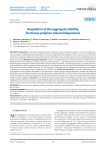
Regulation of the aggregate stability for binary polymer-mineral dispersions
Статья научная
Introduction. In the binary dispersed systems of different origins (mineral and polymer) with particles differing in size by an order of magnitude, heterocoagulation is observed. Regulation of the aggregate stability is crucial in controlling the properties of functional dispersed materials based on such mixed dispersions. This study focuses on the investigation of waterborne mono and binary dispersions of polyvinyl acetate, Portland cement, and chalk by means of static laser light scattering and optical microscopy. Materials and research methods. In order to investigate the action mechanism of the FF modifier based on phloroglucinol furfural oligomers as disperse phase we used chalk (CaCO3 – chalk dispersed technical MTD-2, LLC “Technostroy”, Kopanishchenskoe deposit), Portland cement CEM I 42.5N (JSC “Belgorod Cement”), and polyvinyl acetate (LLC “Kuban-Polymer”). Particle distribution and the aggregate stability of dispersions were studied with an Analysette 22 NanoTecplus device. The particle sizes were determined by optical microscopy with “Axio.Scope.A.1” microscope, and the adsorption of oligomers on the particles of dispersions was analyzed using a UV spectrometer (SPECORD UV). Results and discussion. It has been established that the phloroglucinol furfural modifier contributes to the stabilization of binary polymer-mineral dispersions. Integral and differential distribution curves of polymeric particles have been obtained in a wide range of 0.01–2100 μm. Research has shown the regularity of the modal diameter reduction of adsorption-modified particles with a transition from a narrow to a wider distribution with the absence of large coagulums. Conclusion. The hypothesis has been proposed that the adsorption-solvation factor of aggregate stability makes a significant contribution to the aggregate stability of binary polymer-mineral dispersions. The impact of this factor is different for mono-mineral and binary polymer-mineral dispersions and depends on the hydrophilicity of the surface, increases with the transition from mineral surface to the polymer surface as the Hamaker constant increases.
Бесплатно
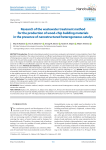
Статья научная
Introduction. Phenols and petroleum products are common wastewater contaminants in many industries. Due to their persistence and toxicity in the natural environment, an efficient waste disposal technology is needed. Ozonation in the presence of heterogeneous catalysts is one of the advanced methods for treating wastewater from these toxicants. Since most catalysts are expensive, they are being sought on the basis of transition metals and their oxides, which have high activity and relatively low cost. In this regard, the Scientific and Educational Center for Innovative Technologies (SECIT) of USPTU carried out work on the search for an effective and affordable catalyst for the deep oxidation of phenol and petroleum products in wastewater under the influence of ozone. Methods and materials. To study catalytic ozonation, we used model waste water containing phenol and oil products at concentrations of 8 and 30 mg/dm3, respectively. Ozonation was carried out in the presence of fresh (1) and spent (2) NiO–MoO3 catalyst deposited in the form of a film on cylindrical Al2O3 granules weighing 0.5 – 2 g. Results. Optimal conditions of ozonation have been found (1), within 10 min of the decomposition process in its presence, COD decreased by 25% compared to the oxidation process with a catalyst (2), and by 40% compared to classical ozonolysis. It was found that the optimal loading of catalyst (1) is 1 g, duration is 35 min, pH = 8.5, temperature – 22 – 30оC, ozone dose – 5 g/dm3. Discussion. At catalyst dosages of less than 1 g/dm3, the low efficiency of removing phenol and hydrocarbons is probably due to a lack of the adsorption surface of the catalyst. Conclusion. The studied method of purification allows to reduce the content of phenol and oil products to the standard indicator of drinking water quality (0.001 and 0.05 mg/dm3, respectively), COD by 96% and solve the problem of the harmful effects of these toxicants on ecosystems.
Бесплатно
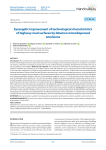
Статья научная
Introduction. The use of bitumen microdispersed emulsion as a resource-saving method for road surface construction is a popular trend in the development of innovative nanostructures. The technological use of petroleum bitumen as a binder for road materials requires a reduction in rheological viscosity. This can be achieved through synergistic developments that involve the use of various additives and modifiers. Methods and materials. The composition of bitumen microheterogeneous emulsions includes: bitumen-containing raw materials (up to 70–80% of mass); water with hardness up to 6 mg-eq/l (from 20 to 30%); emulsifiers (up to 3%) and other components. For large-tonnage production of water- bitumen emulsions, a colloid mill is the most technologically advanced equipment. Results. Water-bitumen emulsions are formed as a result of two competing processes: crushing (dispersion) and coalescence (merging) of microdroplets of the bitumen dispersed phase. The microheterogeneous bitumen phase is distributed in the aqueous dispersion medium in the form of microdroplets ranging in size from 1 to 10 μm (the main share is made up of bitumen microdroplets with a diameter of 2–4.5 μm). The synergetic durable microstructure of asphalt concrete road surfaces, which is formed by supplementing interaction in the boundary layers of the bitumen binder with the surface of the mineral component, is determined by the dominant interaction of complementary factors. Discussion. The synergetic approach to extending the service life of asphalt concrete road surfaces by using bitumen microdispersed emulsions holds promise for interpreting their evolution. The road construction industry of the Russian Federation at the beginning of the 21st century is characterized by a large-scale revision of regulatory documents, regulating the requirements for the construction and operation of highways. Conclusion. The optimal solution to the current problems of intensive construction and reconstruction of Russian highways is the improvement of technological characteristics of road surfaces by adding bitumen microdispersed emulsions to the composition. In complementary strengthening of weak soils of the road surface of high-speed highways, the use of water-bitumen microdispersed emulsions is also recommended.
Бесплатно
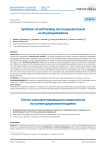
Synthesis of self-healing microcapsules based on dicyclopentadiene
Статья научная
Introduction. The study aims to explore the possibility of creating microcapsules using a carbamide-formaldehyde shell (coat) that contains dicyclopentadiene. Materials and methods. The following reagents were used to synthesize carbamide-formaldehyde microcapsules: distilled water; carbamide (urea) with a purity of 99%; technical formalin; sodium hydroxide (Pro Analysis «PA»); neem seed oil (NSO); polysorbate Twin-80; dicyclopentadiene with a purity of 98%; absolute ethyl alcohol (dehydrated); hydrochloric acid (Pro Analysis «PA»). Results and discussion. Organic microcapsules were obtained by polymerization of carbamide-formaldehyde resin. Filling of microcapsules with dicyclopentadiene has been carried out by establishing equilibrium between concentrated solution of dicyclopentadiene in alcohol and capsule contents. Average size of capsules was ~100 μm. Capsules have spherical shape and solid shell. Fourier-transform IR (FTIR) spectrum confirmed required compositions of capsule shell and filler. Analysis of DSC curve (Differential scanning calorimetry curve) showed that filling of capsules with dicyclopentadiene was successful. Conclusion. The result of the research done is the successful synthesis of microcapsules using a carbamide-formaldehyde shell. This synthesis of microcapsules and its application in building materials technology opens up new prospects for creating composites with selfhealing properties.
Бесплатно
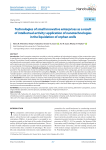
Статья научная
Introduction. Small innovative enterprises are able to solve the problems of technological support of the construction sector. A special place is occupied by enterprises created on the basis of the results of intellectual activity (RIA) of higher educational institutions. The activities of small companies created with the participation of universities have a number of advantages. The scientific and educational environment creates additional opportunities for small businesses in conducting research and development, as well as opens up access to human resources. An example of the commercialization of RIA is the technological developments based on nanomaterial of St Petersburg University enterprises in solving the problem of abandonment of orphan wells, which contribute to the pollution of groundwater. Methods and materials. Abandoned wells are abandoned according to “standard designs” that provide for the abandonment of only the wellbore limited by the inner diameter of the casing pipes, and do not contain technical solutions for the elimination of behind-the-casing flows. Results. An ownerless well, after its abandonment according to the “standard project”, continues to contaminate groundwater, but on a permanent basis, since repeated abandonment of such wells is practically impossible. Each such “abandoned” well is an officially created channel for groundwater contamination in the long term. Discussion. The article contains an analysis of the existing technology of abandonment of wells, including ownerless ones, as well as the justification of the futility of its use to eliminate sources of groundwater pollution. An alternative solution based on the use of modern nanomaterials is proposed. Conclusion. Examples of successful application of the proposed technology with the use of cemented nanomaterials for the liquidation of emergency wells in the North-West region are given. Based on the study, conclusions and recommendations are made.
Бесплатно

Статья научная
Introduction. The article discusses the current state of the possibilities to improve the efficiency of construction processes by using fibre-reinforced concrete in the construction of transport and utility tunnels, as well as other critical building structures. The authors present foreign experience with widespread use of fibre-reinforced concrete in transport construction, as well as few such cases for domestic practice. The inconsistency of domestic experience with the modern state of art has been noted. The main blockers in the development of the issue are under consideration, the theoretical approach and practical application are presented. Materials and methods. The principal aspects of the current approach to the quality indicators of fibre-reinforced concrete and the classification principles of fibre-reinforced concrete based on quality criteria, which are the basis for the normalization of material characteristics, are described. The continuity of domestic and European regulatory documents is shown. Results. Illustrated examples of the possibilities of an optimization approach to the selection of structural solutions in the design of transport construction facilities used in international practice are described. Conclusion. The argumentation in favor of technology development is shown. This opens up possibilities for significant cost reduction justified by a scientific approach. In conclusion, the authors provide recommendations on the general application of the promising material in the domestic practice.
Бесплатно
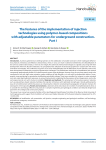
Статья научная
Introduction. A primary geotechnical challenge pertains to the stabilization of unstable soils due to their inadequate deformation, physical, mechanical, and filtration characteristics, which, in turn, can result in abnormal settlements, the destabilization of the soil mass under external loads, or even its own weight. The advent of chemical technologies on a global scale, along with their development within the Russian Federation, has precipitated the utilization of advanced equipment in conjunction with novel, innovative technologies. This confluence has given rise to novel methodologies and the fabrication of new materials, which have been instrumental in addressing a myriad of geotechnical challenges. The predominant methods of soil stabilization with mineral compounds (predominantly based on Portland cement) possess clear advantages; however, they do not always permit work to be conducted in soils with high water saturation, under conditions of high filtration, or in soils with low deformation indices. Consequently, issues pertaining to cementation stabilization periodically emerge. These issues manifest, for instance, in water-saturated rock soils under high hydrostatic pressures, in various fractured soils complicated by the presence of karst depressions, and in silty and organomineral soils with structural instability. Materials and methods. The employment of innovative polymer materials, such as polyurethane-based materials, facilitates the injection of mixtures with optimized strength gain, thereby addressing the issue of soil reinforcement within this process or enhancing the criteria for constraining the propagation of injection mixtures for subsequent cement grouting. Results and conclusion. Laboratory tests and analysis of a number of completed projects allow us to consider this technology effective and practical in complex engineering and geological conditions and beyond design-basis parameters for underground construction projects. This research was carried out using the facilities of the Head Regional Shared Research Facilities of the Moscow State University of Civil Engineering, with support from the Ministry of Science and Higher Education of the Russian Federation (Agreement No. 075- 15-2025-549)
Бесплатно

Статья научная
Introduction. A primary geotechnical challenge pertains to the stabilization of unstable soils due to their inadequate deformation, physical, mechanical, and filtration characteristics, which, in turn, can result in abnormal settlements, the destabilization of the soil mass under external loads, or even its own weight. The advent of chemical technologies on a global scale, along with their development within the Russian Federation, has precipitated the utilization of advanced equipment in conjunction with novel, innovative technologies. This confluence has given rise to novel methodologies and the fabrication of new materials, which have been instrumental in addressing a myriad of geotechnical challenges. The predominant methods of soil stabilization with mineral compounds (predominantly based on Portland cement) possess clear advantages; however, they do not always permit work to be conducted in soils with high water saturation, under conditions of high filtration, or in soils with low deformation indices. Consequently, issues pertaining to cementation stabilization periodically emerge. These issues manifest, for instance, in water-saturated rock soils under high hydrostatic pressures, in various fractured soils complicated by the presence of karst depressions, in dispersed, silty, and organo-mineral structurally unstable soils. Materials and methods. The employment of innovative polymer materials, such as polyurethane-based materials, facilitates the injection of mixtures with optimized strength gain, thereby addressing the issue of soil reinforcement within this process or enhancing the criteria for constraining the propagation of injection mixtures for subsequent cement grouting. Results and conclusion. Laboratory tests and analysis of a number of completed projects allow us to consider this technology effective and practical in complex engineering and geological conditions and beyond design-basis parameters for underground construction projects. The present study was carried out using the material and technical resources of the Main Regional Center for Collective Use of Scientific Equipment and Installations of the Moscow State University of Civil Engineering, with the support of the Ministry of Science and Higher Education of the Russian Federation (agreement No. 075-15-2025-549).
Бесплатно
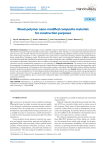
Wood-polymer nano-modified composite materials for construction purposes
Статья научная
Introduction. The advantages of nano-modified composite materials for construction purposes based on polyvinyl chloride (PVC) include enhanced strength characteristics compared to other materials [1]. Composite nanomaterials based on plant resources are versatile materials, whose properties can be modified through additives and processing technology to obtain a wide range of products in various application areas, particularly in construction, decking, outdoor and garden furniture, siding, picket fences, packaging, pallets, and much more. The research aims to investigate the influence of different additives on the technological and operational properties of the resulting composite. Nano-modified composite materials based on PVC are superior to polyolefin composites in terms of stiffness and strength, have high light-resistance as well as resistance to many chemicals, and are comparatively inexpensive as raw materials [2]. Methods and materials. The research aims to determine the preparation of composite materials that provide a highly effective stabilizing system against thermal decomposition, which increase the flow properties of the polymer melt, reduce water sorption, and impart sufficiently high outdoor stability; therefore, products made from composite materials can be successfully used in the construction area. Results. Research results have shown that the use of nanostabilizers in the technology of producing building materials can ensure preservation and ageing quality of polymer composites. They also have application potential on industrial scale. Conclusion. Investigations carried out on the use of a number of nanostabilizers, give to construction composites higher color retention and therefore increase environmental resistance of material.
Бесплатно

